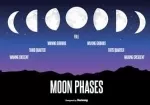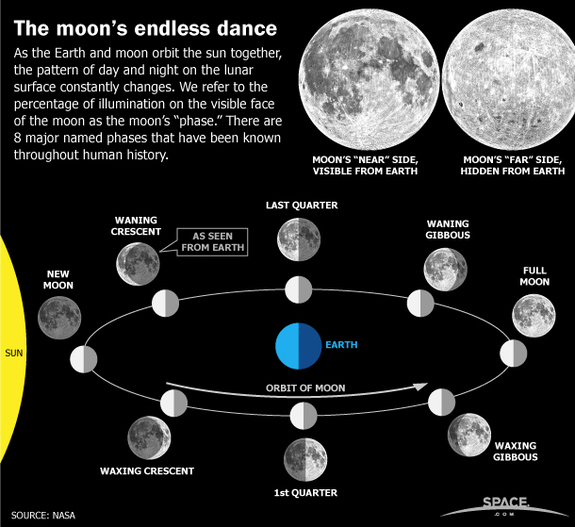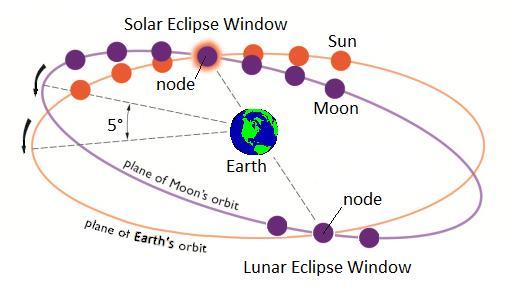Full Worm Moon

The Full Worm Moon, according to space.com,will light up the skies Sunday (March 12) at 22 degrees Virgo 13. This will be the lastfull moonof the winter season, rising just eight days before the vernal equinox, or spring.
In the U.S., the moon will be at its fullest at 9:54 a.m. EDT (1454 GMT). Because the moon rises in the evening for viewers along the East Coast, many Americans will not see the moon at peak fullness. The moon, however, will be between 99 and 100 percent illuminated from March 11 to March 13, so there will be plenty of time to check out its brightly glowing face.
Skywatchers in Hawaii will be able to catch the exact moment the moon is fullest before sunrise, at 4:54 a.m. HST, while those in the Middle East and surrounding areas of the Eastern Hemisphere will see the moon reach peak fullness after it pokes over the horizon in the evening.
There's some leeway with these estimates because of differing points of view on Earth and time zone differences — not to mention that daylight saving time also begins on March 12 (so don't forget to set your clocks forward 1 hour at 2 a.m. local time). To find out exactly when the moon will rise at your location, try searching for the word "moonrise" along with the name of your city.
The full moon of March is known as the Worm Moon because it happens when temperatures rise and the earthworms start to reappear, according to the Old Farmer's Almanac. It was also called the Sap Moon, as it's when the maple trees could be tapped to make syrup again after a long winter of frozen sap. Celtic people called the March full moon the "moon of winds." And, according to "A Dictionary of the Choctaw Language" (published in 1915), the Choctaw people called it the "big famine" – perhaps because it was the season when winter food stores would start to run low.

See the moon phases, and the difference between a waxing and waning crescent or gibbous moon, in this Space.com infographic about the lunar cycle each month. Credit: Karl Tate, SPACE.com
A full moon occurs every 29.5 days when the side of the moon that faces the Earth is fully illuminated. Sometimes this happens during the day, as the exact time of full illumination depends on where the moon is in its orbit around the Earth, and not a viewer's local time. A full moon's peak can also occur after moonset and before moonrise, when the moon is not visible at all. But skywatchers everywhere in the world can still enjoy the full moon for about a day before and after its peak, when it will appear just as full to the casual viewer.
The moon has different phases because we see it from different perspectives as it revolves around the Earth. It moves across the sky relatively quickly; if you look carefully, you can watch it move east against the background of stars by about half a degree, or one moon diameter, per hour. Over the course of a 12-hour night, as the stars rise and set across the sky, the moon will move 6 degrees relative to its surroundings — that's a bit more than the width of three fingers held at arm's length. This causes it to set several minutes later than the stars that rose around it.
When viewed from Earth, both the sun and moon move along a path in the sky called the ecliptic, the plane of Earth's orbit around the sun. Projected against the sky, the ecliptic is tilted 23.5 degrees to the celestial equator, with the high point in the constellation Gemini and the lowest in Scorpio and Sagittarius. Since the moon when full is on the opposite side of the sky from the sun, it is low in the sky when the sun is high, and vice versa – so winter full moons (for people in the Northern Hemisphere) will be high in the sky, while summertime full moons tend to be lower. This full moon will rise from the constellation Leo, a few degrees west of Jupiter.
Since the sun and moon move in the same plane across the sky, you might wonder why eclipses don't occur every month. The moon's orbit is itself inclined to the ecliptic (by about 5 degrees), so most of the time from the point of view of Earth, the new moon "misses" the sun. Only once every few years will the moon line up with the sun exactly from the point of view of a given place on Earth. People across the U.S. will see this happen during the total solar eclipse of Aug. 21, 2017. Lunar eclipses are more common, because Earth casts a larger shadow on the moon than the moon can cast on Earth.

The moon's orbit tilt of 5 degrees from the ecliptic produces two points in space, called nodes, where the orbital planes intersect. When the sun is near one of the nodes, an eclipse may occur. During a new moon, the moon crosses the sun in a solar eclipse. During a full moon, the moon passes through Earth's shadow and darkens in a lunar eclipse. The half-degree diameters of the sun and moon provide an extended window of opportunity, called an eclipse season, twice per year.Credit: Chris Vaughan
The full moon in March will be at a middling altitude in the sky. Occurring just eight days before the vernal equinox (and the first day of spring in the Northern Hemisphere), the moon will be close to the celestial equator. This means that observers in mid-northern latitudes will see the full moon about 45 degrees above the horizon, where it will be relatively easy to point to and unlikely to be obscured by buildings or terrain.
Because the moon's orbit is misaligned with the ecliptic and the moon is moving so rapidly across the sky is why moonrise and moonset don't necessarily coincide with sunset and sunrise. According to timeanddate.com, viewers in New York City will see the nearly full moon set at 7:19 a.m. EDT on March 12, just 7 minutes after sunrise. The moon will rise again in the evening at 7:13 p.m. EDT, 13 minutes after sunset.
When the moon is full, it's easier to see some details on its surface, such as craters and large, dark areas called maria. The maria are lava plains created by huge impacts that penetrated the moon's outer crust. Telescopes and binoculars can help reveal more surface features, but the full moon is so bright that a special filter is needed to dim all that sunlight reflecting off its surface. In fact, if looking with a larger telescope, it's harder to see details of the lunar terrain during the full moon, because there are few shadows amid all that light. Photographing the moon's surface can be more difficult during its full phase than with its other phases.
Images: Free Vector Moon Phases - vecteezy.com
Tags:
#full#worm#moon,#22#degrees#virgo,#full#moon,#astrology,#moon#phases,#starzpsychics.com,#starz#advisors






